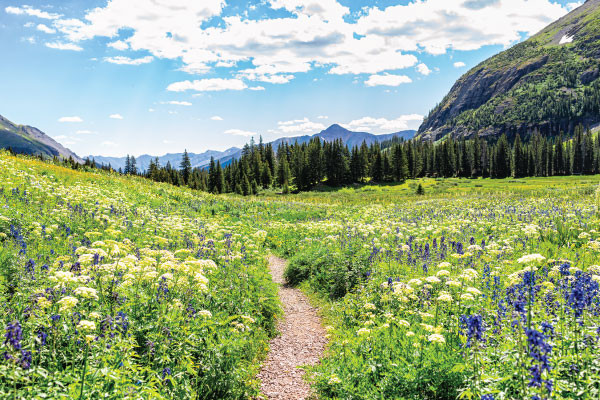Backpacking Ice Lakes Basin: Big Views, Low Impact
Posted by Aaron Hussmann on 5th Aug 2022
Set in a verdant alpine bowl at 12,000 feet in the San Juan Mountains of southern Colorado is the awe-inspiring Ice Lakes Basin. The peaks that stand guard here top out over 13,000’, many of them featuring distinct, craggy formations such as the shattered spine of Pilot Knob (13,744’), the crooked spire of Golden Horn (13,780’), and the notched ramp up Vermillion Peak (13,894’). Gushing white streams of snowmelt flow through fields of lush alpine tundra and wildflowers, spilling into lakes so blue and irridescent they seem like a dream. Bulging, rounded, rock walls are streaked with lines of black and grey, delineating the upper and lower portions of the basin. This majestic landscape could easily be one of the most scenic in Colorado.
The sheer, stunning beauty of Ice Lake lures day hikers, trail runners, and backpackers to tackle the 5-6 mile roundtrip hike up a heart-pounding, thigh-burning 2,420 feet of elevation gain. A backpacking trip to this unique destination is sure to be the experience of a lifetime. But with its increase in popularity over recent years, the staff and volunteers at the San Juan Mountains Association and San Juan National Forest who manage the land and maintain the trails need your help to protect this gem while you enjoy it. A visit to the pristine shores of Ice Lake can be repeated for years to come by following these simple tips on your next backpacking adventure in the Colorado tundra.
One Trail For Everyone

The trail to Ice Lakes basin traverses through pine forest and treks through lush meadows filled with Columbine flowers and stalks of corn lilies. This beautiful vegetation is increasingly prone to trampling in recent years as more and more visitors take to the trails to take in Ice Lake’s majesty. It is a common practice for hikers to step off trail to avoid seasonal mud. This practice has resulted in the formation of a second trail: one beautifully constructed path with water bars and stairs, and another user-created, parallel trail crumbling and eroding downhill as more and more hikers turn the route into two-way traffic. Visitors to Ice Lakes can help prevent this scarring of the landscape and stop this erosion by taking the time to stop and yield. As a general guideline, hikers huffing and puffing uphill have the right of way. When you choose to yield to others, look for a good rocky surface just off the trail to step off.
Number Two To Go
Hands down the easiest way to ruin your outdoor adventure is to encounter the wadded up remnants of someone else’s toilet paper. In Ice Lakes Basin, the soil below the alpine tundra is so rocky and firm that waste disposal can be tricky. Overnight backpackers can help protect the vibrant landscape and crystal clear waters of Ice Lake by choosing to use and pack out a human waste disposal bag like the GoAnywhere, Restop, or Biffy Bag. These easy-to-use bags prevent the harmful contaminants in our waste from polluting Ice Lakes Basin and sure beat bursting into a sweat trying to carve a cathole out of the rocky terrain. You can even learn how to use one of these bags from the folks at the Leave No Trace Center for Outdoor Ethics. If you do manage to dig a cathole, be sure you are 200 feet (approximately 70-80 large steps) away from any water sources and that your hole is 6-8 inches deep. When you’re all set, pack out your toilet paper in a ziplock bag.
New Digs Every Night

Set up your camp at least 200 feet (70 large steps) away from water to prevent erosion into Ice Lake’s crystal waters. Because it’s virtually impossible to avoid camping on the tundra, backpackers staying longer than one night should think about moving their tent each night to let the vegetation underneath recover. Similar to how most house parties result in a crowded kitchen, our camp kitchens also receive the most use. Set up your kitchen area on durable rocks rather than on tundra vegetation.
Ditch the Campfire

Level Up

If you’ve enjoyed your visit to Ice Lakes Basin and want to take the next step in protecting this beautiful destination, consider volunteering for or giving to the San Juan Mountains Association. Take the initiative to learn more about Leave No Trace Outdoor Ethics and pass the knowledge on to friends, family, and other hikers.
Written by Aaron Hussmann for RootsRated and legally licensed through the Matcha publisher network. Please direct all licensing questions to legal@getmatcha.com.
Share on:

